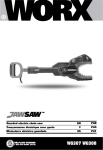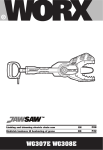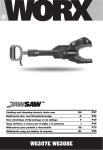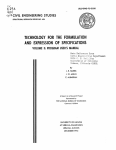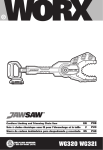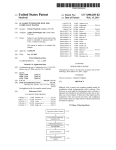Download Worx WG307E Technical data
Transcript
SAFETY AND OPERATING MANUAL Limbing and Trimming Electric Chain Saw WG307E WG308E General Power Tool Safety Warnings WARNING! Read all safety warnings and all instructions. Failure to follow the warnings and instructions may result in electric shock, fire and/or serious injury. Save all warnings and instructions for future reference. The term “power tool” in the warnings refers to your mains-operated (corded) power tool or battery-operated (cordless) power tool. 1) Work area safety a) Keep work area clean and well lit. Cluttered or dark areas invite accidents. b) Do not operate power tools in explosive atmospheres, such as in the presence of flammable liquids, gases or dust. Power tools create sparks which may ignite the dust or fumes. c) Keep children and bystanders away while operating a power tool. Distractions can cause you to lose control. 2 2) Electrical safety a) Power tool plugs must match the outlet. Never modify the plug in any way. Do not use any adapter plugs with earthed (grounded) power tools. Unmodified plugs and matching outlets will reduce risk of electric shock. b) Avoid body contact with earthed or grounded surfaces, such as pipes, radiators, ranges and refrigerators. There is an increased risk of electric shock if your body is earthed or grounded. c) Do not expose power tools to rain or wet conditions. Water entering a power tool will increase the risk of electric shock. d) Do not abuse the cord. Never use the cord for carrying, pulling or unplugging the power tool. Keep cord away from heat, oil, sharp edges or moving parts. Damaged or entangled cords increase the risk of electric shock. e) When operating a power tool outdoors, use an extension cord suitable for outdoor use. Use of a cord suitable for outdoor use reduces the risk of electric shock. f) If operating a power tool in a damp location is unavoidable, use a residual current device (RCD) protected supply. Use of an RCD reduces the risk of electric shock. 3) Personal safety a) Stay alert, watch what you are doing and use common sense when operating a power tool. Do not use a power tool while you are tired or under the influence of drugs, alcohol or medication. A moment of inattention while operating power tools may result in serious personal injury. b) Use personal protective equipment. Always wear eye protection. Protective equipment such as dust mask, non-skid safety shoes, hard hat, or hearing protection used for appropriate conditions will reduce personal injuries. c) Prevent unintentional starting. Ensure the switch is in the off-position before connecting to power source and/or battery pack, picking up or carrying the tool. Carrying power tools with your finger on the switch or energising power tools that have the switch on invites accidents. d) Remove any adjusting key or wrench before turning the power tool on. A wrench or a key left attached to a rotating part of the power tool may result in personal injury. e) Do not overreach. Keep proper footing and balance at all times. This enables better control of the power tool in unexpected situations. f) Dress properly. Do not wear loose clothing or jewellery. Keep your hair, clothing and gloves away from moving parts. Loose clothes, jewellery or long hair can be caught in moving parts. g) If devices are provided for the connection of dust extraction and collection facilities, ensure these are connected and properly used. Use of Limbing and Trimming Electric Chain Saw WG307E WG308E a qualified repair person using only identical replacement parts. This will ensure that the safety of the power tool is maintained. dust collection can reduce dust-related hazards. 4) Power tool use and care a) Do not force the power tool. Use the correct power tool for your application. The correct power tool will do the job better and safer at the rate for which it was designed. b) Do not use the power tool if the switch does not turn it on and off. Any power tool that cannot be controlled with the switch is dangerous and must be repaired. c) Disconnect the plug from the power source and/or the battery pack from the power tool before making any adjustments, changing accessories, or storing power tools. Such preventive safety measures reduce the risk of starting the power tool accidentally. d) Store idle power tools out of the reach of children and do not allow persons unfamiliar with the power tool or these instructions to operate the power tool. Power tools are dangerous in the hands of untrained users. e) Maintain power tools. Check for misalignment or binding of moving parts, breakage of parts and any other condition that may affect the power tool’s operation. If damaged, have the power tool repaired before use. Many accidents are caused by poorly maintained power tools. f) Keep cutting tools sharp and clean. Properly maintained cutting tools with sharp cutting edges are less likely to bind and are easier to control. g) Use the power tool, accessories and tool bits etc. in accordance with these instructions, taking into account the working conditions and the work to be performed. Use of the power tool for operations different from those intended could result in a hazardous situation. 5) Service a) Have your power tool serviced by ADDITIONAL SAFETY POINTS FOR YOUR ELECTRIC JAW SAW 1.Keep all parts of the body away from the saw chain when the jaw saw is operating. Before you start the jaw saw, make sure the saw chain is not contacting anything. A moment of inattention while operating jaw saws may cause entanglement of your clothing or body with the saw chain. 2. Always hold the jaw saw with your right hand on the rear handle and your left hand on the front handle. Holding the jaw saw with a reversed hand configuration increases the risk of personal injury and should never be done. 3. Wear safety glasses and hearing protection. Further protective equipment for head, hands, legs and feet is recommended. Adequate protective clothing will reduce personal injury by flying debris or accidental contact with the saw chain. 4. Do not operate a jaw saw in a tree. Operation of a jaw saw while up in a tree may result in personal injury. 5. Always keep proper footing and operate the jaw saw only when standing on fixed, secure and level surface. Slippery or unstable surfaces such as ladders may cause a loss of balance or control of the jaw saw. 6. When cutting a limb that is under tension be alert for spring back. When the tension in the wood fibres is released the spring loaded limb may strike the operator and/or throw the jaw saw out of control. 7. Use extreme caution when cutting brush and saplings. The slender material may catch the saw chain and be whipped toward you or pull you off balance. Limbing and Trimming Electric Chain Saw WG307E WG308E 3 4 8.Carry the jaw saw by the front handle with the jaw saw switched off and away from your body. When transporting or storing the jaw saw always fit the guide bar cover. Proper handling of the jaw saw will reduce the likelihood of accidental contact with the moving saw chain. 9.Follow instructions for lubricating, chain tensioning and changing accessories. Improperly tensioned or lubricated chain may either break or increase the chance for kickback. 10.Keep handles dry, clean, and free from oil and grease. Greasy, oily handles are slippery causing loss of control. 11.Cut wood only. Do not use jaw saw for purposes not intended. For example: do not use jaw saw for cutting plastic, masonry or non-wood building materials. Use of the jaw saw for operations different than intended could result in a hazardous situation. 12.Hold the power tool by insulated gripping surfaces only, because the saw chain may contact hidden wiring or its own cord. Saw chains contacting a “live” wire may make exposed metal parts of the power tool “live” and could give the operator an electric shock Kickback is the result of tool misuse and/or incorrect operating procedures or conditions and can be avoided by taking proper precautions as given below: 1.Maintain a firm grip, with thumbs and fingers encircling the jaw saw handles, with both hands on the saw and position your body and arm to allow you to resist kickback forces. Kickback forces can be controlled by the operator, if proper precautions are taken. Do not let go of the jaw saw. 2.Only use replacement bars and chains specified by the manufacturer. Incorrect replacement bars and chains may cause chain breakage and/or kickback. 3.Follow the manufacturer’s sharpening and maintenance instructions for the saw chain. Decreasing the depth gauge height can lead to increased kickback Causes and operator prevention of kickback: Kickback may occur when the nose or tip of the guide bar touches an object, or when the wood closes in and pinches the saw chain in the cut. Tip contact in some cases may cause a sudden reverse reaction, kicking the guide bar up and back towards the operator. Pinching the saw chain along the top of the guide bar may push the guide bar rapidly back towards the operator. Either of these reactions may cause you to lose control of the saw which could result in serious personal injury. Do not rely exclusively upon the safety devices built into your saw. As a jaw saw user, you should take several steps to keep your cutting jobs free from accident or injury. Limbing and Trimming Electric Chain Saw WG307E WG308E SYMBOLS Read the manual Warning Wear eye protection Wear ear protection Wear dust mask Do not expose to rain Remove plug from the mains immediately if the cable is damaged or cut. 5 RCM approval mark Warning of danger from overhead electric-power lines Limbing and Trimming Electric Chain Saw WG307E WG308E 8 6 9 5 10 11 12 13 7 14 6 2 17 4 3 2 1 21 16 15 19 Limbing and Trimming Electric Chain Saw WG307E WG308E 1. Power cord 2.Lock out button 3. Rear handle 4.Trigger switch 5.Oil level window 6.Oil filler 7.Front handle 8. Motor 9. Jaw teeth 10.guide bar 11.Saw chain 12.Chain access cover 13.Chain access cover nut 14.Auxiliary position 15.Chain tensioner bolt 16.Sprocket 17.Lock pin 18.Lock pin receptacle (See Fig. B3) 19.Oil bottle 20.Extension pole (only for WG308E, See Fig. Z4) 21.Cable hook Not all the accessories illustrated or described are included in standard delivery. Limbing and Trimming Electric Chain Saw WG307E WG308E 7 TECHNICAL DATA 220-240V~50/60Hz Voltage 600W Rated power 3000/min No load speed Guide bar length 150mm Oil tank capacity 30ml Chain pitch 6.4mm Chain gauge 1.3mm Chain speed 5.5m/s 42 Number of chain links Weight WG307E 3.7kg (without pole) WG308E 5.3kg (with pole) ACCESSORIES 8 WG307E WG308E Wrench 1 1 Oil bottle 1 1 Lock pin 1 1 Cable hook 1 2 Chain oil (100ml) 1 1 Extension pole (WA0163) / 1 We recommend that you purchase your accessories from the same store that sold you the tool. Use good quality chain oil. Use only replacement bar and chain of the same specification. Your retailer can advise the correct purchase. Limbing and Trimming Electric Chain Saw WG307E WG308E INTENDED USE This JawSaw has been designed for pruning branches and cutting small logs up to 100mm in diameter, not for cutting metals (See Fig. A). 100mm ADJUSTMENT AND ASSEMBLY WARNING: Before touching the chain or making any other adjustments, make sure that the tool is switched off and unplugged. All saw chains wear and become loose from operation. Periodically check the chain, if there is any visible gap between the chain and the guide bar, it must be re-tensioned. WARNING: Unplug JawSaw from power source before adjusting saw chain tension. WARNING: Cutting edges on chain are sharp. Use protective gloves when handling chain. This product comes fully assembled. However, we recommend that you check the chain tension before use and readjust if necessary. A 17 B1 ADJUSTING THE CHAIN TENSION 1. Push the handle until the bar is in the middle of the jaw opening as shown. Lock the bar in the middle position by inserting the lock pin (17) found on the power cord into the lock pin receptacle (18) located under the handle (See Fig. B1-B3). 9 17 B2 18 B3 F Limbing and Trimming Electric Chain Saw WG307E WG308E 2. Open the chain access cover (12) by using the f To open turn the supplied wrench. access cover nut front 1/4 turn anti-clockwise. (See Fig. C) 3. Release tension on the chain by loosening the chain tensioner bolt (15). Turn the chain tensioner bolt antic clockwise 2aor more times. (See Fig. D) back 4. Re-tighten the chain tensioner bolt by turning the chain tensioner bolt. When tightening the chain tensioner bolt the automatic chain tensioning system will set the tension b to the chain at the same time. 5. Check that the correct chain tension has been set. G1 be possible to pull the chain away from the J It should side of the bar approximately 3mm and it should snap back. (See Fig. E) If tension is incorrect, repeat step 3, ensuring the bar is free to move when the tensioner is released. 12 C 15 D 10 3mm E CHANGING THE GUIDE BAR AND CHAIN WARNING: Laceration hazard. Always wear protective gloves when installing or removing the saw chain. The saw chain is sharp and can cut you even when it is not running. WARNING: Burn hazard. The chain guide bar and chain may become hot during use. Allow to G2 adjustment or removal. K cool before 1.Ensure the operation is carried out on a firm surface. 2.Disconnect the power, install the lock pin and open the chain access cover as described in the previous section. 11 3.Use only WORX replacement bar and chain. 10 4.Loosen and remove the chain tensioner bolt. 5.Lift the guide bar (10) and chain (11) out through the jaw, angling the bar to clear the two bar locating pins (d) (see Fig. I). 6.If replacing the bar, remove the mounting plate (a), which is retained by a single screw and fit to the new bar. The bar is symmetrical and may be mounted H L with either face outward (can be reversed if the lower working edge is worn) (See Fig. F). e 16 a F d I Limbing and Trimming Electric Chain Saw M WG307E WG308E 7.Before re-fitting the bar, check that the small oil hole (b) and chain slot (c) are not 12blocked by dirt or sawdust, use a small toothpick to clean if necessary (See Fig. G1,G2). 8.Refit the chain to the bar. Note the correct direction of the teeth (See Fig. H). The cutting direction is 100mm inward on the lower cutting edge. 9.With the mounting plate (a) toward the motor and holding the chain in place on the bar, feed bar and chain into the jaw, angling over the bar locating pins (d) and engaging the chain on the drive sprocket (16) (See Fig. I). C There is little excess chain length, therefore, the chain must be properly fitted in the bar slot to provide enough extra chain to be pulled over the drive sprocket. f a front c back b G1 15 D G2 11 10 3mm E H e 16 a F Limbing and Trimming Electric Chain Saw d I WG307E WG308E 11 10.Check if all parts are seated properly (See Fig J). 11.Refit and tighten the chain tensioner bolt. Note the cam (e) of the tensioner will engage the projecting tab (f) of the bar mounting plate and push the bar outward to tension the chain, check for correct tension (See Adjusting the chain tension). 12.Close the access cover and remove the lock pin. LUBRICATION J N IMPORTANT: The JawSaw is shipped with an empty oil tank. It is essential to fill with chain oil before use. Bar and chain oil of any brand can be used. 2 Never operate the JawSaw without chain oil or an empty tank as this will result in poor cutting performance, motor overloadI and possible burn-out. I K g 12 6 5 L M 4 II FILLING OIL TANK: UNPLUG THE TOOL BEFORE FILLING WITH OIL. 1. Fill oil bottle with bar oil.(See Fig. K) 2. Rest the JawSaw with the oil filler (6) facing upward. O 3. Uncrew the oil filler cap (g) open. 4. Use bottle to fill oil reservoir (See Fig. L). 5. Screw the oil filler cap (See Fig. M). IMPORTANT: Use only the recommended oil to avoid damage to the JawSaw. Never use recycled/old oil. Use of non approved oil will I invalidate theIIwarranty. CHECKING THE AUTOMATIC OILER The JawSaw uses a much lower chain speed than a conventional chainsaw so it needs much less oil. However it is very important that it always has oil. Check P1 the oil level window (5) and refill as necessary. During operation, periodically check the chain and bar. A slight oil presence should be visible. If the chain and bar appear completely dry, then remove the bar and chain (see previous section) to ensure the bar oil I hole is not blocked. If the oil hole is clear, there is oil in the tank and still no oiling of the chainII is visible – contact Worx customer service. P2 Limbing and Trimming Electric Chain Saw WG307E WG308E OPERATION front PREPARE YOUR JAWSAW FOR USE WARNING: Read and understand all instructions. Failure to follow all instructions listed may result in electric shock, back and/or serious personal injury. fire WARNING: Sharp moving blade. To prevent accidental operation, ensure that the tool is disconnected from the power source before performing the following operations, failure to do this could result in serious J personal injury. CAUTION: Sharp moving blade. Always wear protective gloves when installing or removing the chain, the chain is sharp and can cut you when it is not running. ATTACHING EXTENSION CORD 1. To prevent disconnection of appliance cord, secure extension cord to extension cord retainer. 2. An extension cord retainer is supplied to reduce strain on the power cord. To use this feature, form a loop at the end of the extension cable and bring this through the opening at the cable hook and suspend in the tension relief at K the hook. (See Fig. N) 3. Keep extension cord clear of the saw and any obstacles at all times. Do not expose the cord to heat, oil, water, or sharp edges. g WARNING: Never operate a Jawsaw 6that is 11 damaged or improperly adjusted or that is not completely and securely assembled. Be sure that the10saw chain stops moving when the power control system triggers are released. Never adjust the guide bar or saw when power cord is connected. SWITCHING ON AND OFF The trigger is locked to prevent accidental5starting. There are two lock out buttons (2), to allow upright L the top) or inverted (cutting up (cutting down from from the bottom) operation. To switch on, press either lock out button with your thumb and squeeze the trigger (See Fig. O). To switch off, just release the trigger. CUTTING Check oil level window (5) prior to starting and regularly during operation. Refill oil when oil level is low. Check newly replaced chain tension approx. every 10 minutes during operation. Always hold secondary handle firmly when cutting (See Fig. P1, P2) M Limbing and Trimming Electric Chain Saw N 2 I I 4 II O 13 I II P1 I II P2 WG307E WG308E Q 1 1/3 R1 14 1 1/3 2 2/3 2 2/3 1. Connect saw and extension cord to power. 2. Use both hands to grip saw firmly. Always use left hand (I) to grip front handle and right hand (II) to grip the rear handle. Thumbs and fingers must wrap around saw handles (See Fig. P1,P2). 3. WARNING: Make sure your footing is firm and stable. Do not use the JawSaw while standing on piles of branches or while standing on a ladder. Hint: When cutting branches which are lying on the ground, place one foot on the branch to prevent limb from moving (See Fig. Q). TWARNING! Do not put your foot in the Jaw X teeth, keep your foot a safe distance from the tool. (See Fig. Q) 4. Position the tool with the Jaw placed over the desired branch to be cut. WARNING: DO NOT force the cut. Let the chain pull through the wood. WARNING: When starting the saw make sure the chain is not in contact with the limb or branch to be cut. 5. Switch on the tool. 6. Push the rear handle towards the front handle to complete the cut. U off the tool after the bar and chain have Y 7. Switch return to their starting position. WARNING: When completing the cut (step 6 Y above) do not push the handle forcefully, let the spinning chain pull itself through the wood. WARNING: Using too much force on the rear Z handle when cutting can overload the tools motor. Z kg CAUTION: At the end of each cut be prepared to support the tools weight. Y R2 S TRIMMING BRANCHES: Before cutting any branch, you must consider the V Z1 following: 1.Is the branch heavy, will it damage anything when it falls? • Large branches should be cut in small sections starting at the farthest end from the tree. • Always check where the branch will fall BEFORE commencing the cut. • Never stand under a branch being cut. • Never cut two branches at once. 2.Will the branch split before it is cut through? (See Fig. R1, R2) • To prevent splitting, use the JawSaw inverted, make a small cut (less than 1/3 diameter of the W Limbing and Trimming Electric Chain Saw Z2 WG307E WG308E R2 limb) from the underside. • Then turn the JawSaw over to the normal position and cut from top down, slightly further out from the trunk than the initial undercut. 3.Is the branch under tension, will it spring suddenly or trap the saw when it is cut? • Always stand outside the path of a springy branch. It can strike suddenly with surprising force and cause injury or loss of control of the saw. • Always cut from the tension side of a branch, usually the top of a branch on a standing tree, but can be any side of the branch of a fallen tree. • If the cut starts to close on the saw, you are cutting from the wrong side, keep the saw running and pull the saw to retract the blade from the cut. • If the saw becomes trapped do not try to pull it out with excessive force, lift the branch to open the cut while an assistant removes the saw. KICKBACK SAFETY This saws chain is covered by a guard however, kickback can still occur. The following steps will reduce the risk of kickback. • Use both hands to grip saw while saw is running. Use firm grip.QThumbs and fingers must wrap around saw handles. • Keep all safety items in place on saw. Make sure they work properly. • Do not overreach. • Keep solid footing and balance at all times. • Stand slightly to right side of saw. This keeps your 2 body from being line with chain. 1 in direct 1/3 • Do not let guide bar nose touch anything when 2/3 chain is moving. • Never try cutting through two logs at same time. Only cut one log at a time. • Do not bury guide bar nose or try plunge cut R1 using guide bar nose). (boring into wood • Watch for shifting of wood or other forces that may pinch chain. • Use extreme caution when reentering a previous cut. 1 1/3 • Never use a dull or loose chain. Keep chain sharp with proper tension. S T 15 U Y Z Z 2 GENERAL BEHAVIOR 2/3 secure footing. Hold the Use the JawSaw only with JawSaw at the right-hand side of your body. (See Fig. S) The chain must be running at full speed before it R2 Limbing and Trimming Electric Chain Saw kg Y V WG307E WG308E V Z1 Z5 makes contact with the wood. Use the metal jaw teeth to secure the saw onto the wood before starting to cut. (See Fig. T) Do not operate the JawSaw with arms fully extended or attempt to saw areas Iwhich areIIdifficult to reach, or on a ladder. (See Fig. U) CUTTING WOOD UNDER TENSION (See Fig. V) WARNING: When cutting a limb that is under tension, use extreme caution. Be alert for wood springing back. When wood Z2 is released, the limb could spring back AA tension and strike operator causing severe injury or death. When sawing logs supported on both ends, start the cut from above(Y) about 1/3 of the diameter into the log and then finish the cut (Z) from below, in order to avoid contact of the JawSaw with the ground. When sawing logs supported on only one end, start the cut from below (Y) about 1/3 of the diameter into the log and finish the cut from above (Z) in order to avoid log splitting or jamming of the tool. W LIMBING A TREE (See Fig. W) Limbing tree. Z3 is removing the branches from a fallen AB1 When limbing leave larger lower limbs to support the log off the ground. Remove the small limbs in one cut as illustrated. Branches under tension should be cut from the bottom up to avoid binding the JawSaw. X 16 BUCKING A LOG (See Fig. X) Bucking is cutting a log into lengths. It is important to make sure your footing is firm and your weight is evenly distributed on both feet. Follow the simple 20 1 directions for easy cutting. WARNING: (See Fig. Y) • If on slope, make sure log will not roll down hill. Z4 AB2 Secure log by using wooden stakes. Drive wooden stakes into ground on downhill side of log. Stand on uphill side of log while cutting. Log may roll after cutting. (See Fig. Y) • Never try cutting through two logs at same time. This could increase the risk of kickback. • While cutting log, never hold log with your hand or leg. • While cutting log, never allow another person to hold log. • Turn off and unplug saw before moving from one place to another. Y Z1 Z5 Limbing and Trimming Electric Chain Saw I II AB3 WG307E WG308E V Z1 ASSEMBLING THE EXTENSION POLE (ONLY FOR MODEL WG308E) WARNING: Before attaching the extension pole (20), make sure that the tool is switched off and unplugged. 1. Turn the release lever to allow the handle clamp to spring open (See Fig. Z1). 2. With the pole slightly angled away from the tool, insert the steel tab W into the slot behind the front handle, then swing the pole towards the tool’s rear handle. (See Fig. Z2). 3. Position the pole handle clamp inside the JawSaw’s rear handle as shown in Fig Z3. To allow the clamp to properly fit the handle, push lock out button and depress the trigger. 4. Close the clamp, the locking lever will automatically lock into place. 5. Check that the rear handle is properly fitted to the clamp and check that the clamp is properly set in the lock position. 6. Plug in the tools power cord to the extension pole power cord . (See Fig. Z4) X Before attaching the power WARNING! cord of the machine to the power cord of the extension pole ( in Fig. Z4), make sure that the tool is switched off and unplugged from the power supply. WARNING! When using this machine with the extension pole, make sure that attaching the power cord of the machine to the power cord of the extension pole, and then attach the power cord of the extension pole to power supply. WARNING! ELECTROCUTION HAZARD Never useYthe JawSaw or extension pole in an area with overhead power lines or where the branch being cut can come into contact with overhead power lines. kg Cutting with shoulder strap (WHEN USED WITH OPTIONAL POLE ATTACHMENT) (See Fig. Z5) The Extension Pole is supplied with a shoulder strap that gives extra support when hoisting the Jaw Saw in the air. Hook the shoulder strap to the Extension Pole and wrap around your shoulder. The shoulder strap can also soften the impact if the JawSaw is dropped after the completion Z1 of a cut. Limbing and Trimming Electric Chain Saw I II I II Z2 Z3 17 20 1 Z4 Z5 WG307E WG308E Z5 AA AB1 18 AB3 CUTTING WITH EXTENSION POLE (ONLY FOR WG308E) 1. Attached the pole as described in ‘’Assembling the extension pole’’. 2. Connect the JawSaw to extension cord. Connect extension cord to power supply. NOTE: The JawSaw is quite heavy on the end of the extension pole. Add the pole attachment when cutting limbs above shoulder height and remove the pole saw when cutting limbs at or below shoulder height. AB4 3. Lift JawSaw with extension pole upward one step by one step. (See Fig. AA) To raise to the vertical position, lift by the Jawsaw first, then hand over hand along the pole. 4. Before cutting a high branch, consider all the same points detailed in the previous section “Trimming Branches” but pay particular attention to the likely path of the falling branch. WARNING: Do not stand directly below a branch being cut. Keep bystanders far away. Do not stand on a ladder or other type of unstable support while using the tool. Do not use the tool near cable, electrical power or telephone lines. Keep 3m away from all power lines. (See Fig. AB1-AB4) 5. Position the Jaw perpendicularly on the branch being cut. NOTE: Maximum cutting capacity of JawSaw is 100mm. AB2 AB3 Limbing and Trimming Electric Chain Saw WG307E WG308E Z5 6. One hand should firmly grip the push handle of the extension pole. The other hand should hold the metal portion of the pole or the sliding handle on the pole (See Fig. AC). 7.IIComplete the cut as described in “Trimming Branches”. 8. At the completion of the cut, be ready to immediately support the weight of the entire tool as the branch falls. WARNING: Do not let the JawSaw fall to the ground at the completion of the cut, AA this may damage the tool. AB3 AB4 SAW MAINTENANCE AND KICKBACK SAFETY Follow maintenance instructions in this manual. Proper cleaning of saw and chain, and guide bar maintenance, can reduce chances of kickback. Inspect and maintain saw after each use. This will increase the service life of your saw. NOTE: Even with proper sharpening, risk of kickback can increase with each sharpening. AC MAINTENANCE AND STORAGE OF JAWSAW 1. Unplug the JawSaw from power source: • When not in use. • When transporting. • When left unattended. • Before servicing. • Before fitting the extension pole. • Before cleaning. • Before changing accessories or attachments, such as saw chain and guard. 2. Inspect the saw before and after each use for: • Any signs of damage, especially the power cord. • Smooth action of push handle and movement of bar. • Adequate chain tension. • Adequate chain lubrication. 3. Do not use the JawSaw, if: • The trigger switch or lockout is malfunctioning. • The push handle does not smoothly return under spring force. • Any other damage which affects the safety or operation is evident. Limbing and Trimming Electric Chain Saw 19 i h AD WG307E WG308E 4. Maintain the JawSaw with care and have any damage or malfunction repaired by an authorized service center: • Never expose the JawSaw to rain. • Keep chain sharp, clean, and lubricated for better and safer performance. • Follow steps outlined in this manual to sharpen chain. • Keep handles clean and free from oil. • Keep all screws and nuts tight. • Never carry the JawSaw by the power cord. • Never yank the power cord to unplug it. • Keep power cord away from heat, oil and sharp edges. • Inspect extension cords and do not use if damaged. 5. When servicing, use only identical replacement parts. 6. When not in use, always store JawSaw • In a high or locked place, out of children’s reach. • In a dry place. 20 REPLACING SAW CHAIN/CHAIN BAR Replace chain when cutters are too worn to sharpen or when chain breaks. Only use replacement chain noted in this manual. Always include new drive sprocket when replacing chain. This will maintain proper driving of chain. Inspect guide bar before sharpening chain. A worn or damaged guide bar is unsafe. A worn or damaged guide bar will damage chain. It will also make cutting harder. To Replace the bar, remove the mounting plate (a), which is retained by a single screw. To fit to the new bar, fit the mounting plate (a) into the new bar by tightening the screw clockwise. The projecting tab (f) must be fitted through the bar slots outwards. (See Fig. F&G1) SHARPENING SAW CHAIN WARNING: Unplug JawSaw from power source before servicing. Severe injury or death could occur from electrical shock or body contact with moving chain. WARNING: Cutting edges on chain are sharp. Use protective gloves when handling chain. Keep chain sharp. Your saw will cut faster and more safely. A dull chain will cause undue sprocket, guide bar, chain, and motor wear. If you must force chain into wood and cutting creates only sawdust with few large chips, chain is dull. Limbing and Trimming Electric Chain Saw WG307E WG308E AC LUBRICATING SPROCKET Note: It is not necessary to remove the chain or bar when lubricating the sprocket 1. Clean the bar and sprocket. 2. Using a grease gun, insert the tip of the gun into the lubrication hole (h) and inject grease until it appears at the outside edge of the sprocket tip (See Fig. AD). 3. To rotate the sprocket and pull the chain by hand until the ungreased side of the sprocket is in line with the lubrication hole (h). Repeat the lubrication procedure. i h AD CLEANING Regularly open the chain access cover and remove any debris that has become trapped. Regularly clean the ventilation slots with a clean, dry paint brush. To clean the tool, use only mild soap and a damp cloth. Never let any liquid get inside the tool and never immerse any part of the tool into liquid. TRANSPORTING Always transport the tool with the guide bar and chain inside the protection guard. 21 Limbing and Trimming Electric Chain Saw WG307E WG308E TROUBLESHOOTING If your saw does not operate correctly check the following: PROBLEMS POSSIBLE CAUSES POSSIBLE SOLUTION • Tool will not start. • Fuse blown or breaker tripped. • Extension cord not plugged in. • Check fuse or breaker. • Check to make sure extension cord is plugged into a working outlet. • Bar / chain overheated. • Chain too tight. • Lubrication needed. • Refer to Adjusting the chain tension section. • Refer to LUBRICATION section. • Chain is loose. • Chain tension set incorrectly. • Refer to Adjusting the chain tension section. • Poor cut quality. • Chain tension set incorrectly. • Chain needs replacement. • Refer to Adjusting the chain tension section. NOTE: Excessive tension leads to excessive wear and reduction in life of bar & chain. • Refer to sections for CHANGING THE GUIDE BAR AND CHAIN. • Unit runs but does not cut. • Chain installed backwards. See Fig H and illustration. • Refer to CHANGING THE GUIDE BAR AND CHAIN section. 22 Limbing and Trimming Electric Chain Saw WG307E WG308E Copyright © 2013, Positec. All Rights Reserved.
























